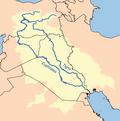Hasankeyf: Difference between revisions
Undid revision 288498551 by 80.132.45.95 (talk) |
No edit summary |
||
| Line 40: | Line 40: | ||
[[Image:HuriyeKüpeli.jpg|thumb|right|Ms. Huriye Küpeli, prefect of Hasankeyf]] |
[[Image:HuriyeKüpeli.jpg|thumb|right|Ms. Huriye Küpeli, prefect of Hasankeyf]] |
||
'''Hasankeyf''' ({{lang-el|Kiphas}}; |
'''Hasankeyf''' ({{lang-el|Kiphas}}; [[Latin]]: ''Cepha''; [[Aramaic]] and [[Arabic language|Arabic]]: ''Hisn Kayfa''; [[Syriac language|Syriac]]: ''Heskîf'' ) is a town and district located along the [[Tigris]] River in the [[Batman Province|Batman]] [[Provinces of Turkey|Province]] in southeastern [[Turkey]]. It is an ancient city, with roots going back 10,000 years. It was declared a natural [[conservation area]] by Turkey in 1981.<ref>{{cite web |url=http://www.kultur.gov.tr/EN/BelgeGoster.aspx?17A16AE30572D3137EE1F1486EE5030E9B41590025722309 |title=Hasankeyf |accessdate=2008-10-23 |publisher=Republic of Turkey Ministry of Culture and Tourism }}</ref> [[Kurdish people]] form the majority in this city.<ref> |
||
[http://www.globalsecurity.org/military/world/war/images/dist-kurdish.gif Distribution of |
[http://www.globalsecurity.org/military/world/war/images/dist-kurdish.gif Distribution of People] — [[GlobalSecurity.org]]</ref> |
||
The [[Ancient Rome|Romans]] had built a fortress on the site and the city became a [[Diocese|bishopric]] under the [[Byzantine Empire]]. It was conquered by the [[Arabs]], in ca. 640, who built a bridge over the Tigris river. The city was successively ruled by the [[Artukids]] and [[Ayyubids]]. The city was captured and sacked by the [[Mongols]] in 1260. Following the [[Ottoman Empire|Ottoman]] ascendancy established by [[Selim I]] in the region in the early 16th century, the city became part of the [[Ottoman Empire]] during Sultan [[Süleyman I]]'s campaign of Irakeyn (the two [[Iraq]]s, e.g. [[Arabian]] and [[Persian Empire|Persian]]) in 1534, at the same time as [[Diyarbakır]], [[Mosul]], [[Baghdad]] and [[Basra]]. |
The [[Ancient Rome|Romans]] had built a fortress on the site and the city became a [[Diocese|bishopric]] under the [[Byzantine Empire]]. It was conquered by the [[Arabs]], in ca. 640, who built a bridge over the Tigris river. The city was successively ruled by the [[Artukids]] and [[Ayyubids]]. The city was captured and sacked by the [[Mongols]] in 1260. Following the [[Ottoman Empire|Ottoman]] ascendancy established by [[Selim I]] in the region in the early 16th century, the city became part of the [[Ottoman Empire]] during Sultan [[Süleyman I]]'s campaign of Irakeyn (the two [[Iraq]]s, e.g. [[Arabian]] and [[Persian Empire|Persian]]) in 1534, at the same time as [[Diyarbakır]], [[Mosul]], [[Baghdad]] and [[Basra]]. |
||
Revision as of 09:27, 31 May 2009
Hasankeyf | |
|---|---|
 | |
| Country | |
| Region | Southeastern Anatolia |
| Province | Batman |
| Area | |
| • Total | 320 km2 (120 sq mi) |
| Population (2000) | |
| • Total | 7,464 |
| • Density | 23.3/km2 (60/sq mi) |
| Time zone | UTC+2 (EET) |
| • Summer (DST) | UTC+3 (EEST) |
| Postal code | 72xxx |
| Area code | +(90)488 |
| Website | www.yerelnet.org.tr |


Hasankeyf (Greek: Kiphas; Latin: Cepha; Aramaic and Arabic: Hisn Kayfa; Syriac: Heskîf ) is a town and district located along the Tigris River in the Batman Province in southeastern Turkey. It is an ancient city, with roots going back 10,000 years. It was declared a natural conservation area by Turkey in 1981.[1] Kurdish people form the majority in this city.[2]
The Romans had built a fortress on the site and the city became a bishopric under the Byzantine Empire. It was conquered by the Arabs, in ca. 640, who built a bridge over the Tigris river. The city was successively ruled by the Artukids and Ayyubids. The city was captured and sacked by the Mongols in 1260. Following the Ottoman ascendancy established by Selim I in the region in the early 16th century, the city became part of the Ottoman Empire during Sultan Süleyman I's campaign of Irakeyn (the two Iraqs, e.g. Arabian and Persian) in 1534, at the same time as Diyarbakır, Mosul, Baghdad and Basra.
Ilısu Dam impact
With its history that spans nine civilizations, the archaeological and religious significance of Hasankeyf is considerable. Some of the city's historical treasures will be inundated if construction of the Ilısu Dam is completed.[3] These include ornate mosques, Islamic tombs and cave churches.
According to the Bugday Association, based in Turkey, Ms. Huriye Küpeli, the prefect of Hasankeyf, the Swiss ambassador to Turkey and representatives of the Swiss led consortium of contractors for the dam project have suggested what they believe to be a suitable nearby spot for moving the historical heritage of Hasankeyf, an operation for which the Turkish Ministry of Culture pledges to provide 30 million euros.[4]
The threat of the Ilisu Dam project prompted the World Monuments Fund to list the city on its 2008 Watch List of the 100 Most Endangered Sites in the world.[5] It is hoped that this listing will create more awareness of the project and prompt the Ilisu Consortium to develop alternate plans that are more sympathetic to this site of exceptional historical and cultural significance.
In December 2008 export credit insurers in Austria, Germany and Switzerland announced suspending their support for the project amid concern about its environmental and cultural impact and gave the Turkish government 180 days to meet standards set by the World Bank.[6]
References
- Blue Guide, Turkey, (ISBN 0-393-32137-1), p. 590.
- ^ "Hasankeyf". Republic of Turkey Ministry of Culture and Tourism. Retrieved 2008-10-23.
- ^ Distribution of People — GlobalSecurity.org
- ^ Ahmed, Kamal (2001-07-01). "UK drops Turkish dam plan". The Guardian News and Media Limited. Retrieved 2008-10-27.
- ^ Hasankeyf Raman Dağı'na taşınıyor
- ^ Davidson, Christina (November 2008). "Turkish Bath". The Atlantic Monthly. pp. 30–31. Retrieved 2008-10-23.
- ^ Insurers halt work on Turkish dam, BBC World, 24 December 2008



